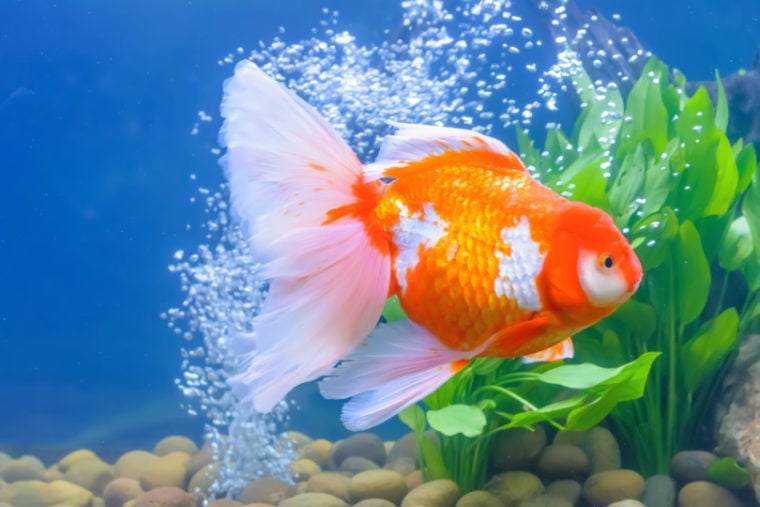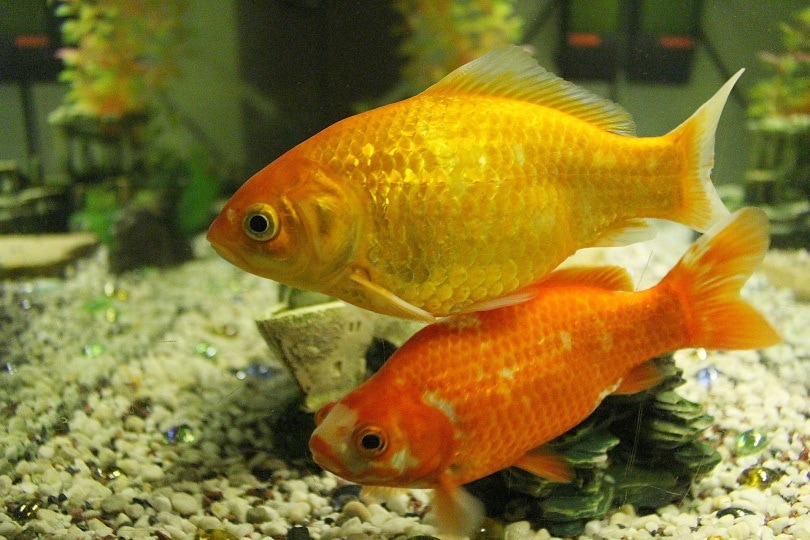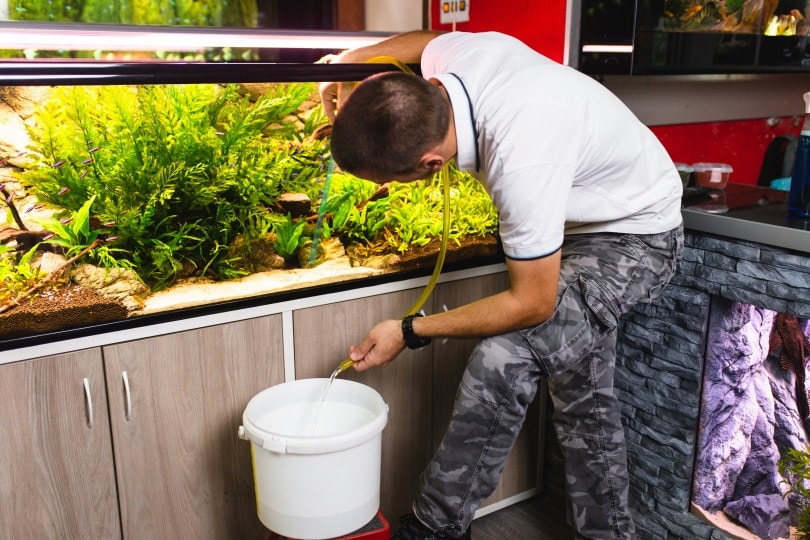
The leading cause of illness and death in goldfish is poor water quality, so monitoring your water parameters is clearly extremely important to the health and wellness of your goldfish. To ensure your goldfish live long lives, you need to understand water parameters and how they work. Armed with that knowledge, you can use water parameter measurements to maintain a healthy aquarium.
Let’s look at the most critical water parameter measurements for your goldfish.
What are Water Parameters?

“Water parameters” refers to specific chemical properties within your aquarium. Each parameter is an indicator the health and water quality of your tank. Taken together, water parameters is essential for:
- Monitoring a cycling tank
- Ensuring your tank’s cycle hasn’t crashed
- Monitoring the quality of your tank water
- Measuring how safe your tank water is for your goldfish, e.g., a low pH doesn’t indicate poor water quality, but it can indicate a dangerous problem for your goldfish
The most important water parameters for you to track in the average goldfish tank are pH, ammonia, nitrite, and nitrate. GH and KH are important but not a major factor in the average goldfish tank. Other water parameters you may need to check include chlorine and heavy metals, like copper.
The 5 Critical Water Parameters to Measure
There are two types of tests that can be used to test most water parameters. Liquid tests are preferred by most for their high level of accuracy, but test strips can be an effective way to check your parameters, especially in a pinch. It’s rare for test strips to check ammonia levels, which are extremely important to monitor in a goldfish tank.
Confirm the kit you purchase can, at minimum, measure pH, ammonia, nitrite, and nitrate levels. For liquid test kits, you will likely have to purchase GH and KH tests separately from the main kit.
Chlorine is usually included on test strips, but it is otherwise considered more of a specialty test. Heavy metals and other parameters you may never need to check are also specialty tests that have to be purchased separately from most test kits.
1. pH
This is a measurement of how acidic, neutral, or alkaline your water is. Tap water usually measures at a pH of 7.0. Everything below 6.9 down to 0 is considered acidic, while everything above that up to 14 is considered alkaline. Goldfish usually prefer neutral to slightly alkaline water with a pH of 7.0–8.0. However, many people have reported their goldfish doing well with pH slightly below 7.0, or up to 8.5.
Acidic water is more dangerous to goldfish than alkaline water is. Acidic water can lead to burns and pain, while alkaline water usually does not unless it is exceptionally high. pH is one of the easiest water parameters to control because it can be altered with things like specific substrates and tank additives.
Always check to verify items are inert before adding them to your tank. This means they will not alter the pH or hardness of your water. Crushed coral and aragonite, for example, are known to increase the pH of water, making it more alkaline. Indian almond leaves and driftwood, on the other hand, are known to decrease the pH of water, making it more acidic.
Never put anything into your tank if you don’t know what it is, like rocks and leaves since this can alter your pH.

2. Ammonia
Ammonia is a waste product that is excreted by goldfish via the kidneys and the gills. In a cycled tank, ammonia levels are kept under control by the presence of nitrifying bacteria, also called beneficial bacteria. These bacteria break ammonia down to a less toxic form, making it less dangerous to your fish and easier to control. A cycled tank should always have an ammonia level of zero.
Goldfish are heavy bioload producers, which means they create a lot of waste in the water. Ammonia levels can build up extremely quickly in a goldfish tank that isn’t cycled or that has a crashed cycle. High ammonia levels can lead to ammonia poisoning. The symptoms of ammonia poisoning include fin loss, scale loss, development of black patches, burns, lethargy, and inappetence, to name a few.
If your tank is experiencing an ammonia spike, small, frequent water changes can help keep the water safe for your fish while your bacterial colonies get set up. Seachem Prime is an excellent product that is added directly to the tank and functions to detoxify ammonia in the tank. This product can really come in handy if you are performing a fish-in tank cycle.

3. Nitrite
Nitrite is produced from ammonia by nitrifying bacteria. Nitrites are as dangerous to the health and well-being of your fish as ammonia. Like ammonia, the nitrite levels in a cycled tank should always be 0.
Nitrites, especially high levels of nitrites, can lead to nitrite poisoning. The symptoms of nitrite poisoning include redness or swelling around the gills, difficulty breathing, abdominal redness, and flashing, which involves the fish shooting around the tank rapidly, and rubbing up against surfaces as if they are itchy or in pain. Goldfish that have developed abdominal redness due to high nitrites are usually in the end stages of nitrite poisoning and little can be done for them.
If you are looking for help to get the water quality just right for your goldfish family in their aquarium, or just want to learn more about goldfish water quality (and more!), we recommend you check out the best-selling book, The Truth About Goldfish, on Amazon today. It covers everything from water conditioners to tank maintenance, and it also gives you full, hard copy access to their essential fishkeeping medicine cabinet!
Managing the nitrite levels in your tank can be done in much the same way as the ammonia levels. While nitrifying bacteria colonies become fully established, you can perform small, frequent water changes to keep the water safe for your fish. Seachem Prime can be used to detoxify nitrite, converting it to a less toxic form.

4. Nitrate
Nitrate is the final waste product produced by the nitrogen cycle. It is a byproduct of the breakdown of ammonia and nitrite. Nitrate is far less dangerous than ammonia and nitrites. In a healthy tank, you will almost always have some low-level nitrates. Most people aim to keep nitrate levels at 20ppm or less, although some people feel that levels from 40–80ppm are safe.
Long term elevation of nitrates can lead to nitrate poisoning. The most distinct symptom of nitrate poisoning involves a spinal curvature developing, making your goldfish become “C”-shaped. You may also see your fish having trouble floating or sinking. Lethargy and inappetence can also be symptoms of nitrate poisoning.
There are two main ways to keep nitrate levels under control, and both are easy to achieve and maintain. Plants absorb nitrate from the water to use for energy, so the addition of aquatic plants and terrestrial plants with roots in the tank, like pothos and peace lily, can help absorb nitrates from the water. The other way to control nitrate levels is with water changes. These should be performed routinely if you are having difficulty controlling your nitrate levels.

5. GH/KH
GH is the general hardness of your water and KH is the carbonate hardness, or alkalinity, of your water. You will see both of these things measured either in degrees of hardness or ppm. The ppm measurement will usually be a large number that is almost always greater than 100. Degrees will usually be less than 20. To get the measurement in degrees from ppm, divide the ppm number by 17.8. So, a GH of 120ppm would be approximately 6.7 degrees, which is on the high end of soft.
GH refers to the amount of calcium and magnesium ions present in the water. These minerals are important for biological and metabolic functions your goldfish need to sustain life. Water with a low GH is considered soft. The higher the GH, the harder the water is considered. Goldfish prefer a GH between 100–300ppm, which is achievable with most tap water.
KH refers to the amount of carbonate and bicarbonate ions in the water, or the buffering capacity. What this means is that the higher the KH, the less likely your tank will be to have rapid changes in pH. On the flip side of this, the higher your KH is, the more difficult it will be to elicit change in your pH levels at all. Goldfish prefer a KH between 70–140ppm.
Wonder shells, Seachem Equilibrium, and crushed coral or aragonite can all be used to raise the GH and KH of the tank. GH and KH are closely related, and it can be difficult to change one without changing the other. Out of the two, KH is more difficult to alter than GH. Seachem Acid Buffer and Seachem Alkaline Buffer are both options for helping to regulate your GH, KH, and pH.
Final Thoughts
Keeping a close eye on your water parameters can be the easiest step you can take to maintain the quality of your tank water and the health of your goldfish. Once your tank is cycled and doing well, you can reduce the frequency at which you check your parameters. During cycling, you will likely be checking the parameters multiple times per week. Having a solid grasp not just of what your parameter numbers should be, but of what those numbers mean will help you understand what may have caused a change in your parameters and how you can fix or prevent the problem.
Featured Image Credit: Decha Photography, Shutterstock








